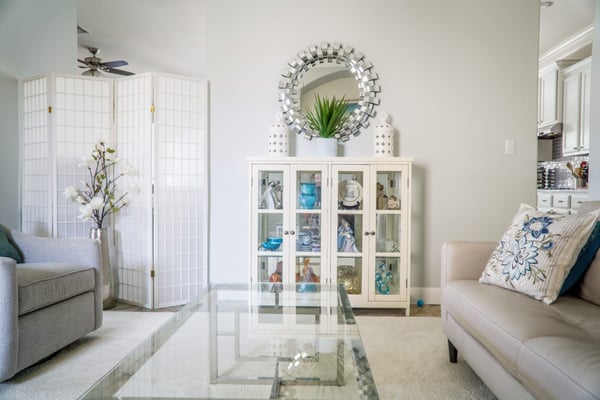If you’ve got a model home as part of your new development, staging it is imperative. You may think that a shiny, newly built home could easily sell itself with nothing in it, but this isn't always true. Many buyers have trouble visualizing their own furniture in a brand new space, and this means they may see the model home they’re touring as simply a house, rather than their future home. What’s more, by placing furniture properly in a model home, and using the correct furniture, buyers are able to not only visualize themselves living in the space, but also see just how all the parts of the home can be used. Below, we’ll share some tips from model home staging experts.
Declutter and Neutralize
Creating a neutral home free of nick-knacks and clutter is essential in staging a model home. Soft, neutral palettes allow potential buyers to not only notice the architectural features of the home, they also help them visualize how they themselves would decorate. While some people may really like bold patterns and bright colors, many may not, and the last thing you want to do is alienate many buyers. And in terms of clutter, while a stack of magazines on a table, f\or example, may make a home look lived in, it can also create a cluttered, messy look - the last impression you want to give buyers. Accent pieces and artwork are great to have, but they should be kept to a minimum and well placed.
According to professionalstaging.com, “"if you’ve ever been into a model home before, you know how easy it is to fall in love with it and want to move right in. That’s because decorators stage these homes with the understanding of a buyer’s psychology. It’s different from decorating for a homeowner which is a far more personalized experience ─ staging a home all about making someone feel comfortable in a space regardless of their personal style.”
Give Every Space a Purpose
Unlike older homes with traditional layouts and standard principal rooms, many newly built homes feature fabulous bonus spaces, offices, mudrooms etc. But if the purpose of these rooms is not shown to potential buyers, they may not even know what they’re for! Turn a moment of confusion into a burst of inspiration by giving any space without an obvious use, a specific purpose. A spare bedroom can be turned into a guest room, or a work space for kids. If there is a split bedroom layout, with one bedroom further away from the rest, consider fashioning it into an in-law suite. A bonus room in a basement or attic can be a home gym or a play area for kids. And a room off the kitchen can be a breakfast nook, a mudroom, or a large walk-in pantry. Knowing who your potential buyers are will help you determine how to stage rooms like these.
Appeal to the Target Market
Knowing your target market may be the most important aspect of staging a home. According to interior designer and staging expert Claudia Jacobs, “A model home is created to capture the attention of the target market for the development. Not every market is the same and it is important to showcase the lifestyle for that market.” For example, if most buyers drawn to your development are older couples or empty nesters, staging a room as a kids play area or nursery shows you aren’t catering to your market. Instead, consider things like a home office, a craft room, or a formal dining room. Conversely, if your demographic is young families with children, a formal dining area may be seen as a wasted space in their eyes that would seldom get used. Instead, consider kid-focused areas, or staging one principal room as a slightly more formal area where parents can entertain their friends, and another one as a more casual family room.
In the end, these simple tips will help make all the difference in your model home. While not every buyer is the same, everyone wants to be able to easily visualize themselves in a space and see it as a place of warmth and comfort. By staging your model home in a neutral, uncluttered way, and showing off the practicality of all the various rooms, you’re helping potential buyers feel inspired and excited.

Recent Posts
- Spec Home Loans: Complete Guide to Construction Financing for Builders
- Spec Construction Loans: A Spec Line of Credit Is Worth the Paperwork
- Spec Homes and Pre-Sale Homes: Relative Benefits for a Spec Builder
- Spec Construction Success: Insights for the Investor Builder
- How Is a Spec House Different From Other Kinds of House Construction?
